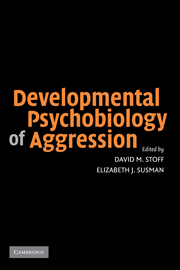Book contents
- Frontmatter
- Contents
- Foreword
- INTRODUCTION
- PART I PLASTICITY
- 2 The Interaction of Biological and Social Measures in the Explanation of Antisocial and Violent Behavior
- 3 Social Deprivation, Social–Emotional Behavior, and the Plasticity of Dopamine Function
- 4 Animal Studies on Inappropriate Aggressive Behavior Following Stress and Alcohol Exposure in Adolescence
- 5 Links Between Girls' Puberty and Externalizing and Internalizing Behaviors: Moving from Demonstrating Effects to Identifying Pathways
- PART II BIDIRECTIONALITY
- PART III GENE–ENVIRONMENT INTERACTIONS
- CONCLUSION
- Author Index
- Subject Index
- References
3 - Social Deprivation, Social–Emotional Behavior, and the Plasticity of Dopamine Function
Published online by Cambridge University Press: 14 July 2009
- Frontmatter
- Contents
- Foreword
- INTRODUCTION
- PART I PLASTICITY
- 2 The Interaction of Biological and Social Measures in the Explanation of Antisocial and Violent Behavior
- 3 Social Deprivation, Social–Emotional Behavior, and the Plasticity of Dopamine Function
- 4 Animal Studies on Inappropriate Aggressive Behavior Following Stress and Alcohol Exposure in Adolescence
- 5 Links Between Girls' Puberty and Externalizing and Internalizing Behaviors: Moving from Demonstrating Effects to Identifying Pathways
- PART II BIDIRECTIONALITY
- PART III GENE–ENVIRONMENT INTERACTIONS
- CONCLUSION
- Author Index
- Subject Index
- References
Summary
BRIAN PLASTICITY AND SOCIAL DEVELOPMENT
The notion of plasticity in relation to biological and behavioral development is not a new one. Even when very little was known about brain structure and function and long before the advent of modern molecular and neuroanatomical techniques, scientists recognized that the brain had the capacity to adapt and change in response to environmental input. Already in 1892, William James stressed the importance of brain plasticity in the organization of habits:
Plasticity, then, in the wide sense of the word, means the possession of a structure weak enough to yield to an influence, but strong enough not to yield all at once. Each relatively stable phase of equilibrium in such a structure is marked by what we call a new set of habits. Organic matter, especially nervous tissue, seems endowed with a very extraordinary degree of plasticity of this sort; so that we may without hesitation lay down as our first proposition the following: that the phenomena of habit in living beings are due to plasticity of the organic materials of which their bodies are composed.
(p. 2, italic original (James, 1892)James's intuition was confirmed in the 1960s when a group of scientists provided the first empirical evidence of environmentally induced alterations in brain chemistry and structure (Diamond, Krech, & Rozenzweig,1964; Krech, Rozenzweig, & Bennett, 1960; Rozenzweig, Krech, Bennett, & Diamond, 1962). Importantly, it was shown that these neurobiological alterations were associated with enhanced behavioral and particularly cognitive functions.
- Type
- Chapter
- Information
- Developmental Psychobiology of Aggression , pp. 43 - 68Publisher: Cambridge University PressPrint publication year: 2005
References
- 1
- Cited by



